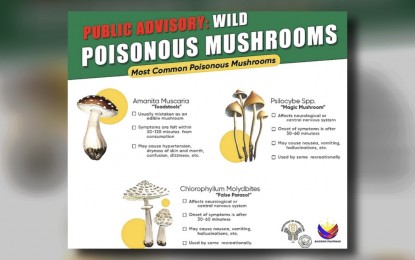
BAGUIO CITY – The Department of Agriculture-Cordillera Administrative Region (DA-CAR) advised against picking of wild mushrooms that are abundant during the rainy season as cases of food poisoning have been reported.
“If you are not sure if these are edible, don’t eat them,” the DA-CAR said in an advisory on its social media page posted on Monday noon.
The DA said the common physical characteristics of poisonous mushrooms, specifically the amanita variants, are warts or scales on the cap, thin white gills or spores, ring-like structures or skirts on their stems, and parasol/ umbrella-shaped caps.
Karen Lonogan, Development Management Officer IV and head of the Regional Epidemiology and Surveillance Unit of the Department of Health-CAR said they have recorded “six (mushroom poisoning) incidents” in May and June.
The DOH-CAR, in its public advisory, said mushrooms that are not edible contain toxins that target the gastrointestinal system and nervous system with symptoms ranging from allergic reactions to abdominal pains, nausea, diarrhea, vomiting, hallucinations and behavioral changes.
The symptoms occur 30 to 60 minutes after eating the so-called magic mushroom while ingestion of the toadstool mushroom will have symptoms within 30 to 120 minutes.
The DOH said severity of the symptoms may depend on the species, toxins and the amount ingested, thus the treatment varies on the symptoms.
“Not all poisonous species are brightly-colored. Most if not all parts of the poisonous mushroom are toxic. Poisonous mushrooms may grow on land or wood, some poisonous mushrooms have toxins that can be tolerated by certain animals or insects. Boiling, drying, salting or removing certain parts of a poisonous mushroom will not detoxify it and not all mushrooms smell or taste horrible,” the DOH advisory said.
Thus, it advised the public to “buy mushrooms from supermarkets or directly from mushroom growers, keep an eye on your kids when they play in areas where mushrooms grow and seek immediate consultation when symptoms arise.” (PNA)
